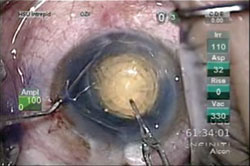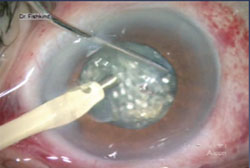Algorithms enhance accuracy of femtosecond laser lens fragmentation
Distinct cutting patterns enable surgeons to break up lens nuclei without phaco energy, clinician says.
 William J. Fishkind |
CHICAGO — Surgeon feedback can play a key role in determining appropriate femtosecond laser lens fragmentation patterns for different cataract grades, according to a study presented here.
William J. Fishkind, MD, reported results at the joint meeting of the American Academy of Ophthalmology and Middle East Africa Council of Ophthalmology.
Surgeons responded to a questionnaire after performing lens fragmentation with the LensAR femtosecond laser system. They evaluated three distinct algorithms and resulting patterns for lens fragmentation.
“We all used different algorithms as we went through the procedure because we were trying to determine which one was the best for each situation,” Dr. Fishkind told Ocular Surgery News in a subsequent interview. “Not only do the algorithms cut differently, but also different surgeons might use them in different ways. And different algorithms may lend themselves to different nuclear hardness. Those concepts are still being worked out.”
The questionnaire addressed common concerns about femtosecond lens fragmentation and laser removal of cataracts, Dr. Fishkind said.
Results showed that lens fragments may be removed without phacoemulsification energy and that no uncut lens nucleus material remains in the capsule when accurate lens thickness is identified.
The LensAR femtosecond laser is approved by the U.S. Food and Drug Administration for anterior capsulotomy. It has investigational device status for all other indications.
Hydrodissection, chopping, breakup
The prospective, randomized study included data from 110 surgeon respondents to the eight-part questionnaire. Surgeons were asked to evaluate three lens fragmentation patterns: cubes, spheres and pie-shaped cuts (Figure 1).
Questions centered on surgeon ability to hydrodissect the lens nucleus, pre-chop in the radial cuts and break up the lens during phacoemulsification.
 Figure 1. Surgeons rated three algorithms for lens fragmentation: cubes, spheres and pies. Short laser pulses enable precise cutting of the lens nucleus with minimal damage to surrounding tissue. Lens fragments can be removed without phaco energy. |
 Figure 2. A spherical approach proved most effective in fragmenting grade-3 (moderate) cataracts in a recent study. Images: Fishkind WJ |
 Figure 3. A pie-shaped cut proved most effective in fragmenting grade-4 (hard) cataracts in a recent study. |
Study results showed that about 50% of surgeons who used the cube pattern and 35% of those who used the sphere pattern were completely able to perform hydrodissection (Figure 2). About 70% of surgeons who used the pie cuts were somewhat or completely able to hydrodissect lens nuclei (Figure 3). Roughly 85% of patients who used the pie-cut pattern were able to separate the lens with the pre-chopper.
Dr. Fishkind said the study results reminded him of the preferences that he and colleague Harvey Uy, MD, had while working with the LensAR platform.
“It turned out that what I liked best was the spheres and what he liked best was the pie-shaped cuts,” Dr. Fishkind said. “The reason for that was that I think he was in the Philippines and doing pretty hard nuclei. I was in Mexico City doing moderate to hard nuclei. The difference was that the pie shape allows you to pre-chop and that is what he liked to do, whereas I was using spheres and sort of scraping them out and removing them.”
Ongoing surgeon feedback will help developers further refine software algorithms, Dr. Fishkind said.
Superior docking, imaging
The LensAR femtosecond laser has a built-in rotating Scheimpflug camera with 3-D confocal-structured illumination that provides fast and accurate imaging to the micron level.
“[Imaging] outlines all of the structures with great contrast. So, you can see the cornea, anterior and posterior surfaces, the anterior chamber, the iris, the anterior lens capsule, and the lens material in the posterior lens capsule. It is all very accurate,” he said, adding that optical coherence tomography is not sufficiently fast or accurate for precise femtosecond capsulotomy and lens fragmentation.
“Because the OCT technology images a narrow band, the anterior segment is artificially created by doubling the image,” he said. “So, you can only get one part of the anterior segment imaging. One has to make certain assumptions and then assemble the images, which decreases accuracy. Accuracy is critical.”
Image acquisition took approximately 30 seconds with the prototype LensAR platform and may take about 2 or 3 seconds with the final iteration of the device, Dr. Fishkind said.
In addition, the LensAR platform has a docking mechanism that does not applanate the cornea, so the cornea retains its native curvature. Saline solution is placed between the cornea and the docking device, which allows precise measurement of the anterior cornea without changing the corneal curvature. – by Matt Hasson

- William J. Fishkind, MD, can be reached at 5599 N. Oracle Road, Tucson, AZ 85704; 520-293-6740; fax: 520-293-6771; e-mail: wfishkind@earthlink.net.
- Disclosure: Dr. Fishkind is a paid consultant for Abbott Medical Optics and LensAR Inc. Dr. Uy is a principal investigator for LensAR.
